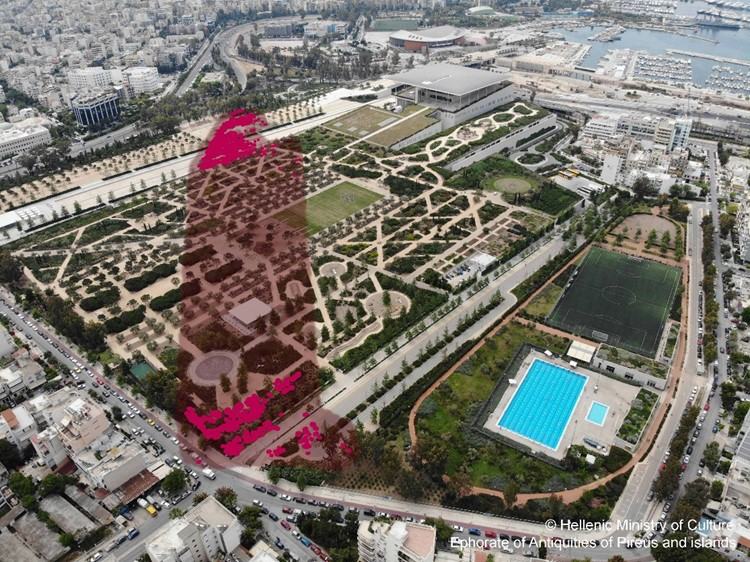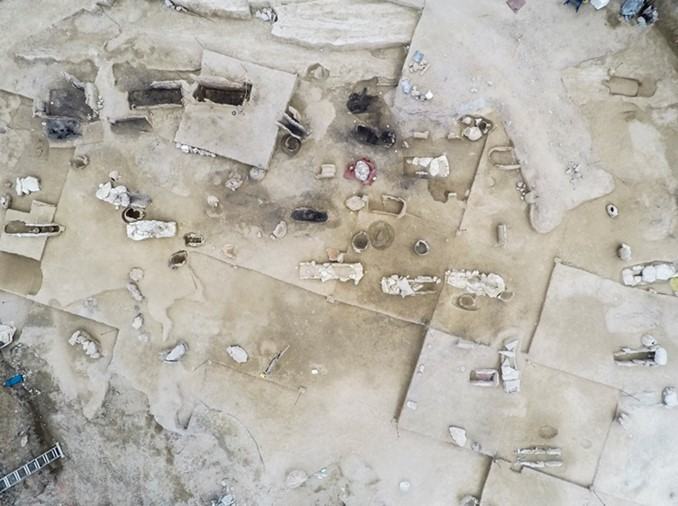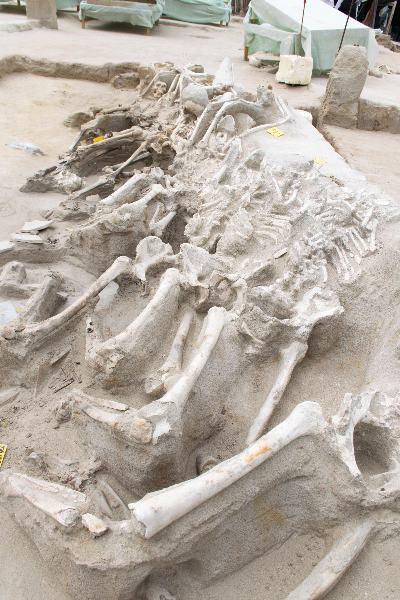The shackled men of Phaleron: A 3D-model of a mass grave found in the Phaleron Delta Cemetery
A collaboration between the Ephorate of Antiquities of Piraeus and the Islands and the Swedish Institute at Athens
Published: 2021-09-09

Fig.1: The location of the cemetery, the probable total area, as seen in the actual Phaleron Bay from NW. ©Hellenic Ministry of Culture and Sports. Ephorate of Antiquities of Pireus and Islands.
The spectacular find of a mass grave in the Phaleron Delta cemetery is now available as a 3D-model, created in the context to a collaboration between the Ephorate and the SIA.
Introduction to the discovery
Stella Chryssoulaki, Ioannis Pappas
The Phaleron Delta cemetery is spatially delimited by the sandy deposits of Phaleron Bay, most of which are not visible today due to the continuous earthworks that were initated at the beginning of the last century and continue uninterruptedly to this day. Excavations at the cemetery began in the late 19th century,[1] continued in the early years of the 20th century[2] and are being pursued to this day after a 100-year hiatus.[3] (Fig.1) It is a spatially extended coastal cemetery, outside of the boundaries and the walls of Athens, but very close to its first harbour.[4] Based on the excavation data, the period of its use can be placed from the last decades of the 8th century BC until the 4th century BC.[5]

Fig.1: The location of the cemetery, the probable total area, as seen in the actual Phaleron Bay from NW.[6] ©Hellenic Ministry of Culture and Sports. Ephorate of Antiquities of Pireus and Islands.
A total of 2115 burials have been discovered, most of them excavated under the supervision of the Ephorate of Antiquities of Piraeus and Islands, during campaigns caused by the construction of the Stavros Niarchos Foundation Cultural Center (2012-2020). (Fig.2) The examined parts of the cemetery cover more than 1 hectare. All types of burials of the period in question are represented, such as pit graves in the sand, burials in reused clay pots (pot burials), cist graves made of local limestone slabs, funeral pyres, burials in small clay tubs (larnakes) and burials covered by tile bricks (tile graves). Animals also lie buried among the human graves, mainly equines which do not seem to accompany their owners.

Fig.2: Eastern part of the cemetery (Esplanade Sector) revealed in 2016. ©Hellenic Ministry of Culture and Sports. Ephorate of Antiquities of Pireus and Islands.
During the excavations of 1915, the remains of mass burials of people who had suffered the punishment of apotympanismos, was exposed, the earliest known mass-burial of executed people in Attica.[7] The recent excavations revealed a significant number of further mass- or individual burials of victims of a violent death (biaiothanatoi). (Fig.3)

Fig.3: View of mass burials from the a) NW Sector and b) the Esplanade Sector. ©Hellenic Ministry of Culture and Sports. Ephorate of Antiquities of Pireus and Islands.
In its southwestern part of the Sector, a mass burial of 79 captives was found, arranged in three trenches (Fig.5). In Trench A, 39 captives were found laid in rows, tied together in groups, and manacled at their wrists (Fig.6). Two oinochoai, dated to the 7th century BC, were found by the lower limbs of two of the in total 46 individuals of the Trench A.[8] An additional seven individuals were discovered at the southern end of Trench A, buried with their arms tied behind their backs (Fig.7). Their posture also differed from the 39, as they were found in a lateral position with their lower limbs bent at right angles.

Fig.4: The excavation area of the Esplanade Sector, view from N. ©Hellenic Ministry of Culture and Sports. Ephorate of Antiquities of Pireus and Islands.

Fig.5: The mass burial of 79 captives (2016), view from S. ©Hellenic Ministry of Culture and Sports. Ephorate of Antiquities of Pireus and Islands.

Fig.6: The 39 captives of the first Trench A, view from SW. ©Hellenic Ministry of Culture and Sports. Ephorate of Antiquities of Pireus and Islands.

Fig.7: The seven individuals at the south-eastern part of the Trench A, view from SE. ©Hellenic Ministry of Culture and Sports. Ephorate of Antiquities of Pireus and Islands.
The second trench was located east of Trench A . There, 16 individuals were found with their arms tied behind their backs (Fig.8); two of them wore a metal ring on the fourth finger of their left hand. In the third trench, carelessly formed, lay 16 individuals, tied together by iron shackles on their wrists (Fig.9). An iron knife was found on one of them, almost tangential and alongside the left tibia, while an arrowhead was found in the chest of another. Unlike the burials of the other two trenches, the 16 of the third trench were probably executed at the spot, as they seem to have fallen on top of each other after being lined up by the grave and killed. Furthermore, a limestone slab, broken into two pieces, was found on top of this third trench. Judging by its location, it could have been placed as a grave-marker, sema, of this deviant burial.

Fig.8: Trench B, view from N. ©Hellenic Ministry of Culture and Sports. Ephorate of Antiquities of Pireus and Islands.

Fig.9: The 16 captives of Trench C, view from NW. ©Hellenic Ministry of Culture and Sports. Ephorate of Antiquities of Pireus and Islands.
The considerable number of burials, the taphonomy, the excellent preservation of the skeletons and the evidence of their dating to the 7th century BC, led to an initial interpretation, which suggested that the buried could be connected to an incident attested through ancient literary sources.[9] This first suggestion aroused the interest of both the scientific community and the general public around the world and led to a Ministerial Decree of the temporary preservation of the discovery in situ, since this part of the cemetery was defined not only as an archaeological site but maybe also as a historical landmark. At the same time, the excavators initiated immediate interdisciplinary documentation, since their experience, formed through several years of work in this particular cemetery, made them realize just how vulnerable the find was. These works made it possible to collect the available data from the context as it was discovered, before being affected by the new environmental conditions, to which it was exposed once excavated.
In the face of the challenge of such an important discovery, the Ephorate searched out modern and accurate methods of surveying and of bioarchaeological documentation in its collaboration with the Swedish Institute at Athens (SIA) (Fig.10). The collaboration with the team of researchers from the SIA proved to be crucial, as within a short period of time it managed to complete the in situ preliminary bioarchaeological field analysis of the 79 captives.[10] At the same time, radiocarbon analyses (C14) were conducted in selected burials, and the results are expected to be published. Moreover, the research team also carried out a 3D-scanning of the mass-grave, offering an extremely useful tool for studying and saving the data available during the period which followed the excavation.[11]

Fig.10: During the works of the SIA (7/2016). ©Hellenic Ministry of Culture and Sports. Ephorate of Antiquities of Pireus and Islands.
______
[1] Proceedings of the Councils of the Archaeological Society 25 May. 8 & 15 June 1863. Meetings of the Members of the Archaeological Society, held on the 10th and the 17th of November 1863, PAE 1864.
[2] Kourouniotis 1911, 246-50; Pelekidis 1916, 13-64.
[3] Chryssoulaki 2018, 89-92; 2019, 103-14; 2020, 132-141; Alexandropoulou 2018, 1-8; 2019, 261-286; Ingvarsson & Bäckström 2019, 7-158; Prevedorou & Buikstra 2019, 60-67.
[4] Chryssoulaki 2019, 105.
[5] Ibid, 105.
[6] We would like to thank Giannis Asvestas and Konstantina Deli for the editing of the photographs and the drawings.
[7] Pelekidis 1916, 45-64; Keramopoullos 1923. Apotympanismos was a capital punishment, similar to the Roman crucifixion.
[8] Ingvarsson & Bäckström 2019, 11.
[9] Herodotus V.71.1-2; Thucydides 1.126.1 – 1.127.3.
[10] The results are published in Ingvarsson & Bäckström 2019, 7-153.
[11] Sincere thanks to the Directors of the Swedish Institute at Athens, Arto Penttinen & Jenny Wallensten, for the long and exceptional cooperation with the Ephorate of Antiquities of Piraeus and Islands.
______
Bibliography
Alexandropoulou, A. 2018. ‘Ein protoattisches fragment aus Phaleron’, in Festschrift für Heide Froning. Studies in Honour of Heide Froning, eds. T. Korkut &B. Özen-kleine, Istanbul., 1-8.
Alexandropoulou, A. 2019. ‘Die kindergrabäber in Phaleron’, in Griechische Nekropolen. Neue Forschungen und Funde (Beiträge zur Archäologie Griechelands, 5), eds. H. Frielinghaus, J. Stroszeck § P. Valavanis, Möhnesee , 261–86.
Chryssoulaki, S. 2018. ‘Δέλτα Φαλήρου. Νεκρόπολη Φαλήρου’, AD 68 (B1), 89–92.
Chryssoulaki, S. 2019. ‘The Excavations at Phaleron Cemetery 2012-2017: An introduction’, in Rethinking Athens before the Persian wars. Proceedings of the international workshop at the Ludwig-Maximilians-Universität München (Munich, 23rd-24th February 2017) (Münchner Studien zur Alten Welt, 17), München, 103–14.
Chryssoulaki, S. 2020. ‘Ομαδικό πορτρέτο με ένα νεκρό’, The Art of Crime 8, 132–41.
Invgarsson, A. & Y. Bäckström 2019. ‘Bioarchaeological field analysis of human remains from the mass graves at Phaleron, Greece. With an introduction by Stella Chryssoulaki and an appendix by Anna Linderholm, Anna Kjellström, Vendela Kempe Lagerholm, and Maja Krzewińska’, OpAthRom 12, 7–158.
Keramopoullos, Α.D. 1923. Ο Αποτυμπανισμός. Συμβολή αρχαιολογική εις την ιστορίαν του ποινικού δικαίου και την λαογραφία (Βιβλιοθήκη της εν Αθήναις Αρχαιολογικής Εταιρείας, 22), Athens..
Koumaris, Ι. 1915. Κρανιολογικαί παρατηρήσεις επί των εν κοινώ τάφω κλοιοφόρων σκελετών του Παλαιού Φαλήρου, Athens.
Kourouniotis, Κ. 1911. ‘Εξ Αττικής. Ανασκαφαί Παλαιού Φαλήρου’, AEphem 50, 246-251.
Pelekidis, Ε. 1916. ‘Ανασκαφή Φαλήρου’, AD 2, 13–64.
Prevedorou, E.-A. & J.-E. Buikstra 2019. ‘Bioarchaeological practice and the curation of human skeletal remains in a Greek context: The Phaleron Cemetery’, Advances in Archaeological Practice 7, 60–7.





